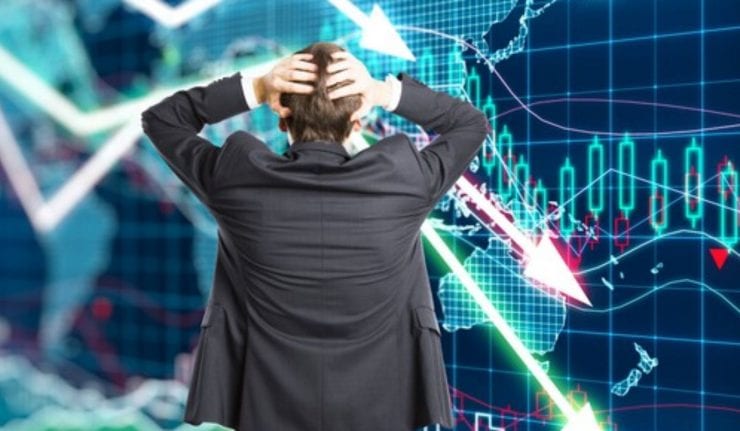Until we take a step back and reflect on the long view of how Wall Street works, there isn’t a whole lot of point in trying to do anything else. It’s ugly out there. Viral fear is spreading.
People with no historical context reach for scary comparisons and come up short. Pessimists might say this week marked the worst market drop since 2008, while optimists might call it the fastest correction in history.
The first statistic is accurate, but misleading. When the market unraveled in the wake of the 2008 Lehman Brothers collapse, stocks plunged 22 percent in five days.
Here over a decade later, the selling has barely reached half that level of fevered intensity. Remember, it took a pillar of Wall Street liquidating to make 2008 a bad dream for investors.
This time around, we’ve gotten a few sales warnings from high-profile companies like Microsoft Corp. (NASDAQ:MSFT) and Apple Inc. (NASDAQ:AAPL) that conditions in China are weaker than expected.
People around the world are sick. But are conditions even half as bad as they were in the face of the Lehman crash?
I don’t think so. That’s what I told Reuters TV this week. (Click to view.) And it’s what I’ll be talking about on Monday in my hour-long online Trading and Investing seminar. (Click to register.)
After all, this ongoing correction might be the fastest one in recent memory, but we’re a long way from the 1987 crash, when the market erased 22 percent of its value in a single day.
The speed at which Black Monday unfolded made even the Lehman implosion look slow and reasonable. What we’ve seen this week was barely a blip on that sharp lurch to the downside.
I know because I was there. We picked up and got back to work. Two years later, the losses had receded in the rear view. After that, even if you bought the pre-crash high, you were in the profit zone.
And the profits only compounded with time. On Black Monday, we were worried about whether the Dow Jones Industrial Average could ever recover the then-lofty 2,000-point frontier.
Now we’re in a place where the blue-chip barometer can fall 2,000 points in a 48-hour period and the world goes on. This is messy and frustrating, but it’s still business as usual.
Getting the Correction in the Rear-view Mirror
While preparing for Monday’s seminar, I was reminded of the way we’ve experienced 2.3 significant downswings every year since the bull market started in 2009.
Some of these retreats have been big, testing the boundary between simple 10 percent “correction” and 20 percent bear market territory. Most have taken about 8 percent out of stock prices before bottoming out.
On those terms, we’re only a little beyond average right now. It’s hardly anything to get worried about. What hurts, of course, is the speed at which stocks have retreated.
A normal downswing takes 20-60 days to play out. This one has been extremely accelerated due to the distance stocks had run up previously and the imponderable nature of the coronavirus outbreak.
We just don’t know who will get sick or what the ultimate economic impact will be. And with the S&P 500 stretching toward 19X earnings before topping out, I suspect a lot of investors were looking for a reason to step to the sidelines.
A correction was due. As we’ve learned in previous epidemic-linked market retreats (zika and ebola come to mind), the bulls will be back once the disease stops spreading and people recover.
Even now, China is reporting only 400 new coronavirus cases a day. While those numbers may not be completely accurate, that’s a successful quarantine given the size of the population and the exponential spread we saw weeks ago.
People get sick in winter. Sadly, thousands die every year. As we heard this week, influenza can kill more Americans in a relatively bad year than coronavirus has infected people around the world throughout history.
Maybe we don’t get as nervous about the flu as we should. I know a few billionaires who are terrified of a mutant outbreak stemming from the “common” influenza virus. They didn’t need anything new to worry about.
But the point for investors is in the numbers. As long as coronavirus behaves like it has so far, the ultimate economic impact will be limited and temporary.
Think of an unusually cold winter. People stay home for a few months. Nobody wants to travel and when they do, the flights are cancelled.
Hotels go empty. A lot of workers call in sick. The economy softens. Then, when the weather improves, we all get back to work. Delayed transactions finally get made and a temporary economic dip turns into a surge.
The long trend remains intact. I suspect the U.S. economy will lose 0.2 percentage point of growth this quarter due to the virus. That’s not a recession. It’s a deceleration.
Next quarter, we’ll probably get that 0.2 percentage point back. And in the grand scheme of things, that 0.2 percentage point is as meaningful to the economy as Boeing Co. (NYSE:BA) freezing 737 production until it figures out how to resolve reliability issues.
Work on those planes stopped last year. The economy hasn’t disintegrated, has it? I could go on, but I want to save something for the discussion on Monday and beyond.
In the meantime, a sinking or sideways market presents opportunities, provided you aren’t content to simply “buy and hold” forever like you’re Warren Buffett.
Yes, Warren Buffett was one of those people who were eager for a market correction. He wants to put $128 billion to work and couldn’t find anything worth buying at 19X earnings.
But “buy and hold” only makes money in the long term. Month to month, it’s dead money up to 75 percent of the time. That’s why I trade around the dull and directionless periods.
And it’s how my 2-Day Trader has booked nearly a 100 percent gain since I launched it in July. That’s including some steep losses in the recent past… we aren’t immune, but the wins outnumber the disappointments.
Upcoming Appearances:
I am so excited to be a speaker at the 1st annual online Women Teach Trading and Investing Conference where many of the world’s top financial educators will showcase their best trading and investing strategies; including short and long term focus that will help you gain the confidence you need to take control of your financial future and earn a consistently profitable return from the global markets.
Join us at NO COST to YOU and learn from these Top Pro Women Traders that trade and invest successfully for a living.
https://xs224.isrefer.com/go/streg/eaglepub/
I will be presenting on Monday, March 2 at 1 pm eastern and the conference runs all week.
Click here now to join us for a full week of trading education!
https://xs224.isrefer.com/go/streg/eaglepub/
Join me at the TradersExpo in New York on Monday, March 9, 8-8:45 a.m. EST, for my special presentation, Faster, Stronger, Richer: The Two-Day Trader. Register for free at Kramer.TradersExpo.com and use my priority code of 049072. The event will take place at the New York Marriott at the Brooklyn Bridge. I hope to see you there!




